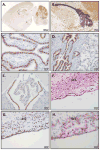Decreased FOXJ1 expression and its ciliogenesis programme in aggressive ependymoma and choroid plexus tumours
- PMID: 26690880
- PMCID: PMC5364032
- DOI: 10.1002/path.4682
Decreased FOXJ1 expression and its ciliogenesis programme in aggressive ependymoma and choroid plexus tumours
Abstract
Well-differentiated human cancers share transcriptional programmes with the normal tissue counterparts from which they arise. These programmes broadly influence cell behaviour and function and are integral modulators of malignancy. Here, we show that the master regulator of motile ciliogenesis, FOXJ1, is highly expressed in cells along the ventricular surface of the human brain. Strong expression is present in cells of the ependyma and the choroid plexus as well as in a subset of cells residing in the subventricular zone. Expression of FOXJ1 and its transcriptional programme is maintained in many well-differentiated human tumours that arise along the ventricle, including low-grade ependymal tumours and choroid plexus papillomas. Anaplastic ependymomas as well as choroid plexus carcinomas show decreased FOXJ1 expression and its associated ciliogenesis programme genes. In ependymomas and choroid plexus tumours, reduced expression of FOXJ1 and its ciliogenesis programme are markers of poor outcome and are therefore useful biomarkers for assessing these tumours. Transitions in ciliogenesis define distinct differentiation states in ependymal and choroid plexus tumours with important implications for patient care. Copyright © 2015 Pathological Society of Great Britain and Ireland. Published by John Wiley & Sons, Ltd.
Keywords: FOXJ1; choroid plexus; cilia; ciliogenesis; dedifferentiation; ependymoma; stem cells; subventricular zone.
Copyright © 2015 Pathological Society of Great Britain and Ireland. Published by John Wiley & Sons, Ltd.
Conflict of interest statement
Figures






Comment in
-
Ciliary transcription factors in cancer--how understanding ciliogenesis can promote the detection and prognosis of cancer types.J Pathol. 2016 May;239(1):6-9. doi: 10.1002/path.4703. Epub 2016 Mar 30. J Pathol. 2016. PMID: 26880325
Similar articles
-
Ciliary transcription factors in cancer--how understanding ciliogenesis can promote the detection and prognosis of cancer types.J Pathol. 2016 May;239(1):6-9. doi: 10.1002/path.4703. Epub 2016 Mar 30. J Pathol. 2016. PMID: 26880325
-
Nuclear expression of Survivin in paediatric ependymomas and choroid plexus tumours correlates with morphologic tumour grade.Br J Cancer. 2003 Nov 3;89(9):1743-9. doi: 10.1038/sj.bjc.6601334. Br J Cancer. 2003. PMID: 14583779 Free PMC article.
-
Differential expression of cell adhesion molecules (CAM), neural CAM and epithelial cadherin in ependymomas and choroid plexus tumors.Acta Neuropathol. 1995;89(3):248-57. doi: 10.1007/BF00309340. Acta Neuropathol. 1995. PMID: 7754745
-
Cytological features of ependymal and choroid plexus tumours.Cytopathology. 2024 Sep;35(5):556-560. doi: 10.1111/cyt.13418. Epub 2024 Jul 10. Cytopathology. 2024. PMID: 38988178 Review.
-
Diagnostic histopathology, cytogenetics, and molecular markers of pediatric brain tumors.Neurosurg Clin N Am. 1992 Oct;3(4):723-38. Neurosurg Clin N Am. 1992. PMID: 1327339 Review.
Cited by
-
Transcriptomic Analyses Reveal Gene Expression Profiles and Networks in Nasopharyngeal Carcinoma.Biomed Res Int. 2021 Jan 25;2021:8890176. doi: 10.1155/2021/8890176. eCollection 2021. Biomed Res Int. 2021. PMID: 33564686 Free PMC article.
-
MicroRNA-6852 suppresses cell proliferation and invasion via targeting forkhead box J1 in gastric cancer.Exp Ther Med. 2018 Oct;16(4):3249-3255. doi: 10.3892/etm.2018.6569. Epub 2018 Aug 2. Exp Ther Med. 2018. PMID: 30214548 Free PMC article.
-
SNO-EANO-EURACAN consensus on management of pineal parenchymal tumors.Neuro Oncol. 2024 Dec 5;26(12):2159-2173. doi: 10.1093/neuonc/noae128. Neuro Oncol. 2024. PMID: 39073785 Free PMC article. Review.
-
Ependymoma associated protein Zfta is expressed in immature ependymal cells but is not essential for ependymal development in mice.Sci Rep. 2022 Jan 27;12(1):1493. doi: 10.1038/s41598-022-05526-y. Sci Rep. 2022. PMID: 35087169 Free PMC article.
-
Distinct patterns of primary and motile cilia in Rathke's cleft cysts and craniopharyngioma subtypes.Mod Pathol. 2016 Dec;29(12):1446-1459. doi: 10.1038/modpathol.2016.153. Epub 2016 Aug 26. Mod Pathol. 2016. PMID: 27562488 Free PMC article.
References
Publication types
MeSH terms
Substances
Grants and funding
LinkOut - more resources
Full Text Sources
Other Literature Sources
Medical
Molecular Biology Databases

